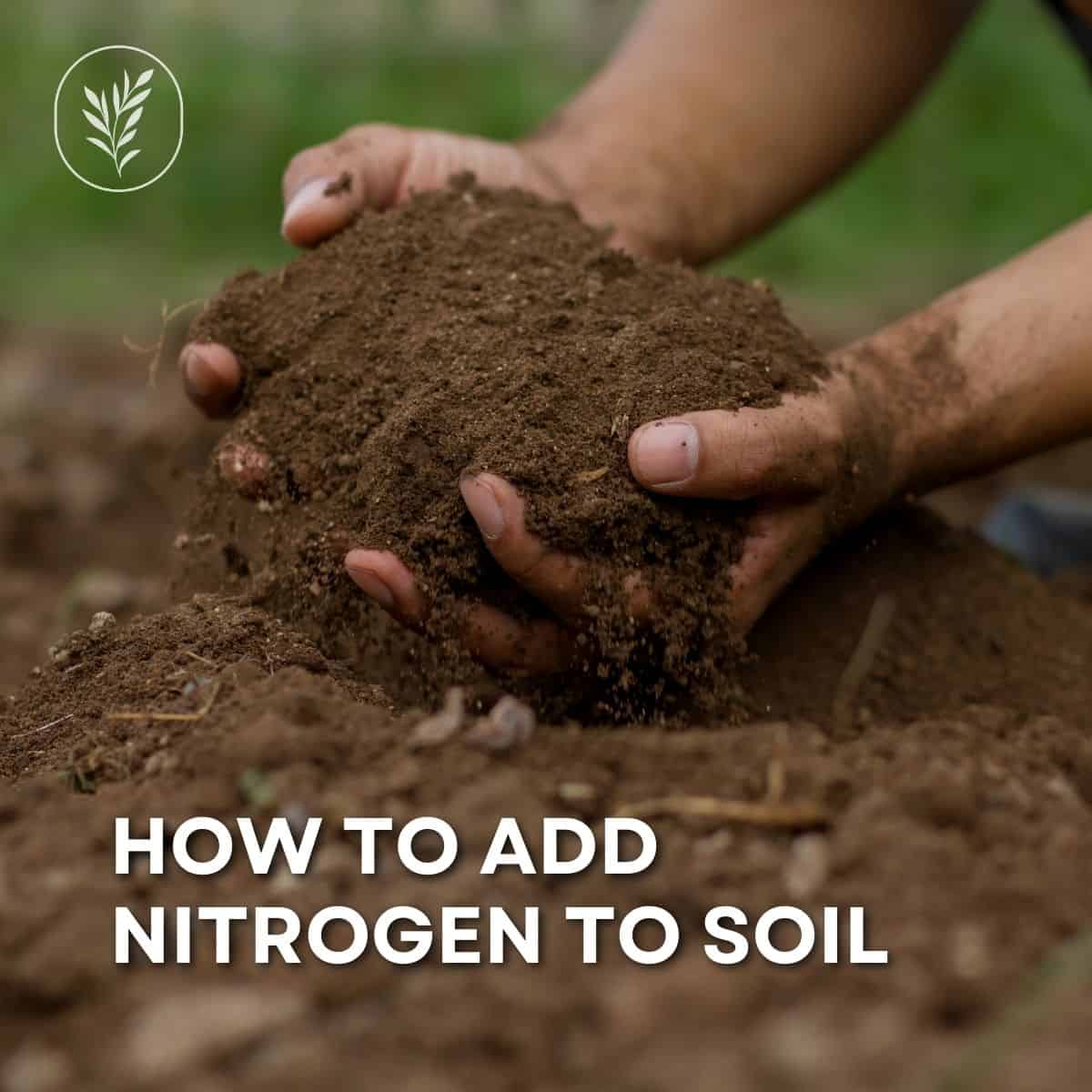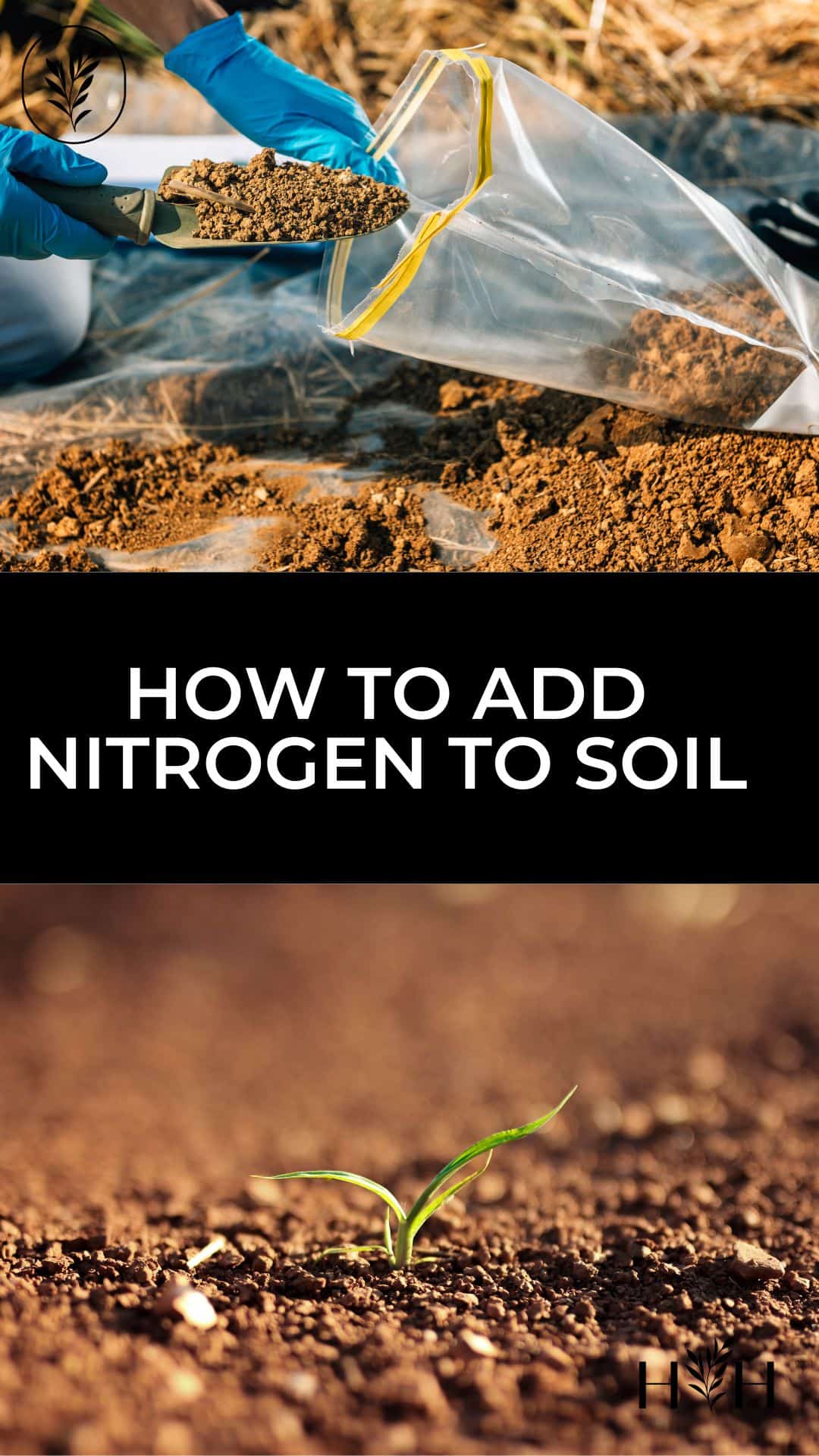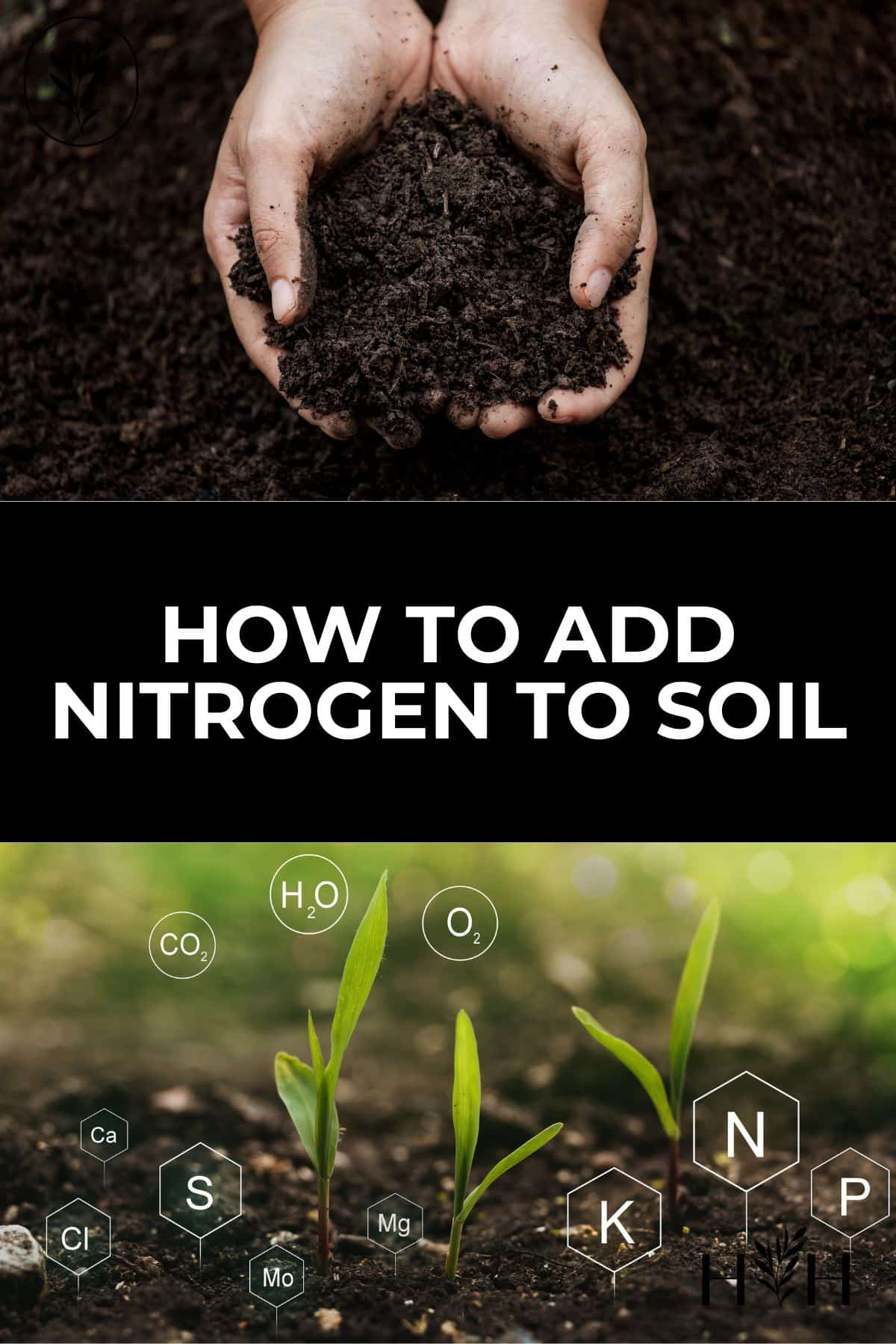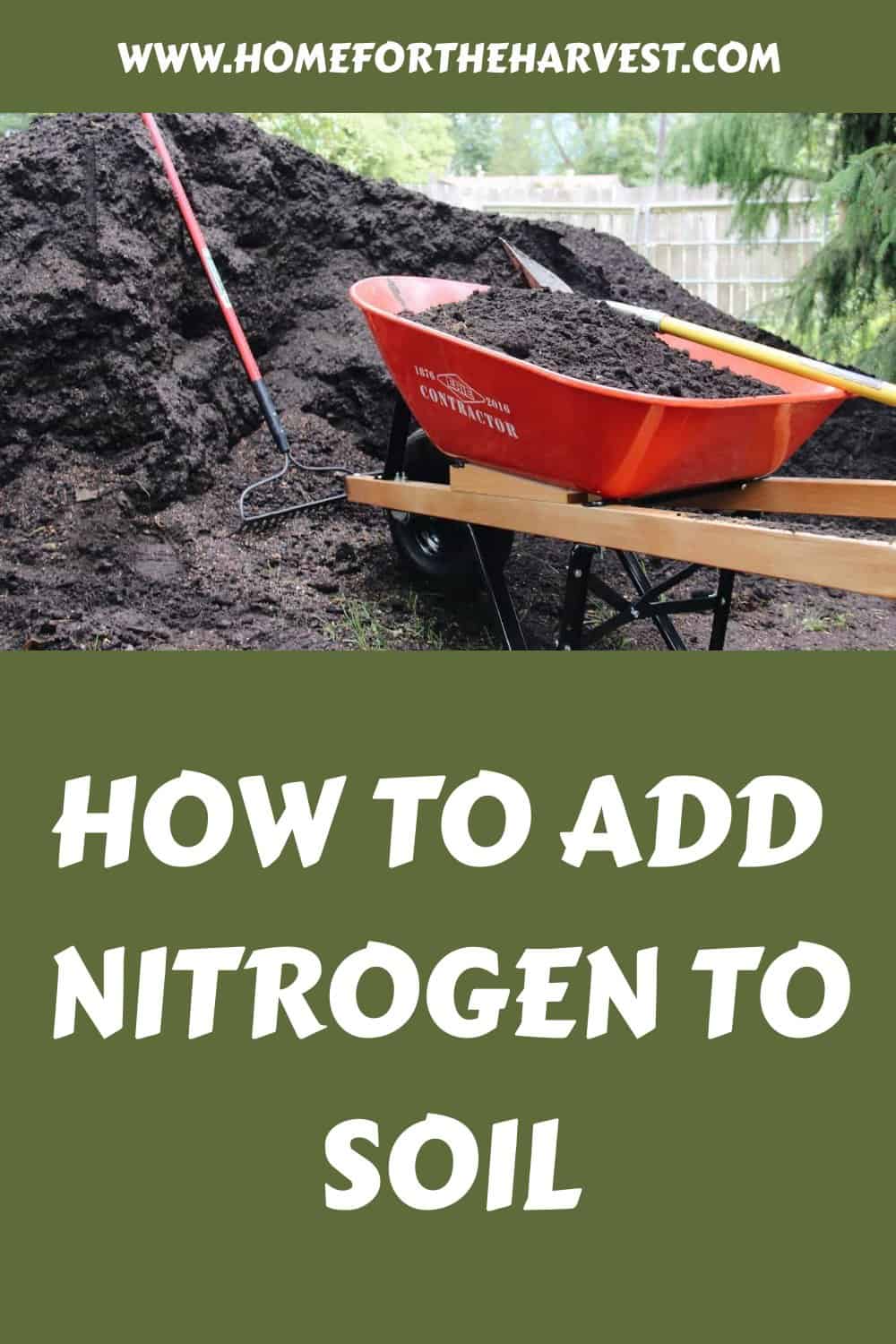Nitrogen is a key nutrient for the health of your plants. Unfortunately, soil in some residential areas has very low levels of nitrogen. Thankfully, there are quite a few organic methods that work quickly to add nitrogen to soil.
Here are some of the best soil amendment materials you can use to add nitrogen to soil:
- All-purpose fertilizer with a high nitrogen content (NPK)
- Lawn fertilizer with a high nitrogen content (NPK)
- Many animal manures (poultry manure, bat guano, worm castings)
- Some plant-based products (seaweed, corn gluten meal, fruit vinegar)
- Fish & animal by-products (fish emulsion, feather meal, blood meal)
- Homemade compost enriched with coffee grounds and yard clippings
- Green manure cover crops that fix nitrogen from the air (peas, beans, clover)
Read on to get all the details for each way to add nitrogen to your soil.

Specific ways to add nitrogen to the soil
Nitrogen deficiency is common in residential gardens. This important nutrient can also be quite tricky to measure accurately with a home soil test. But thankfully, there are lots of ways to fix nitrogen deficiency in the soil. You can increase nitrogen in soil by adding nitrogen-rich fertilizer, composted manure, processed plant-based soil amendments, homemade compost, and even by planting certain crops that can pull nitrogen down into the soil from the atmosphere. These are all great sources of nitrogen for plants.
The fastest way to add nitrogen to soil is by applying a nitrogen-rich liquid fertilizer. This includes certain all-purpose plant foods with a high portion of nitrogen, as well as fertilizers formulated for green plants (especially lawn fertilizers).
To more naturally add nitrogen to your soil, try adding a thin layer of homemade compost or locally-produced composted manure to the top of the soil as a top dressing. Alternatively, plant nitrogen-fixing plants as a cover crop to draw down nitrogen from the atmosphere into the soil.
Here are the details for each of the seven common ways to add nitrogen to your soil.
1. All-purpose organic plant fertilizer with a high nitrogen content (NPK)
High-quality all-purpose organic fertilizer blends are a versatile way to increase the amount of nitrogen available to your lawn and garden plants. All-purpose fertilizer comes in several formats, including granular bits, water-soluble powder, and packaged liquid. The percentage of total nitrogen is listed as the first number (N) in the NPK ratio for each fertilizer. You want to look for packages where the first number in the three-digit ratio is higher than the second two.
Here are some great high-nitrogen organic plant food options:
Espoma plant-tone organic fertilizer (5-3-3)
Espoma Plant-Tone Organic Fertilizer (5-3-3) is one of the most popular all-purpose organic fertilizer blends. Espoma Plant-Tone has a guaranteed minimum amount of 5% total nitrogen. This well-balanced fertilizer is very versatile and can be used on all flowers, vegetables, trees, and shrubs.
Plant-Tone is derived from Feather Meal, Poultry Manure, Bone Meal, Alfalfa Meal, Greensand, Humates, and Potash. Plant-Tone also contains beneficial bacteria (Bio-Tone Microbes).
Established trees and shrubs can be fertilized with Espoma Plant-Tone in the spring. It’s quite easy to apply – simply sprinkle it onto the soil under the plant and then water the area. Small plants can each be fertilized with one cup of fertilizer. Every pound of fertilizer will be enough to feed three small plants. Larger trees and shrubs use more fertilizer at a recommended rate of one cup for each foot of diameter.
Plant-Tone can also be worked into the top few inches of the soil in garden beds. One pound of fertilizer (3 cups) can be mixed thoroughly into every 25 square feet of garden surface soil. For container gardens, 2 cups of Plant-tone can be mixed into each cubic foot of potting mix. Flowers and vegetable plants can be fertilized in this manner once per month during the growing season.
Plant-Tone is available in sizes from 4 pounds up to 50 pounds. Each pound contains about three cups worth of fertilizer. Consider how many plants you’ll be fertilizing to help pick the right size packet.
Miracle-Gro performance organics all-purpose plant nutrition granules (9-2-7)
Miracle-Gro’s Performance Organics line includes a new all-purpose plant food that is relatively high in nitrogen. Miracle-Gro’s Organic Plant Nutrition (9-2-7) has a guaranteed minimum amount of 9% total nitrogen. This concentrated high-nitrogen blend can be used to feed plants, flowers, vegetables, and herbs.
Miracle-Gro Organic Granules are derived from Feather Meal, Soybean Meal, Nitrate of Soda, Bone Meal, Sunflower Hull Ash, Rock Phosphate, and Sulfate of Potash. It does not include beneficial bacteria or fungi.
This fertilizer comes in a convenient
2. Lawn organic fertilizer with a high nitrogen content (NPK)
Lawn fertilizers are formulated specifically to be high in nitrogen, as nitrogen is key for leafy green plants. While some synthetic chemical fertilizers can add too much nitrogen too quickly (and burn plants/cause environmental damage via runoff), organic options are generally safer slow-release options. Many are also marked as safe for use around kids and pets.
Lawn fertilizer is a fast and effective way to increase the amount of nitrogen available to your lawn, trees, shrubs, and garden plants (it’s not just for lawns!). Many lawn fertilizers have the added benefit of 0% phosphorus, making them much less likely to contribute to the pollution of local groundwater and waterways.
Here are some great high-nitrogen lawn fertilizer options:
Espoma organic lawn food (9-0-0)
Espoma Organic Lawn Food (9-0-0) is a turf-grass-specific fertilizer. With no phosphorus or potassium, this concentrated fertilizer is all about nitrogen! Espoma organic lawn food has a guaranteed minimum amount of 9% total nitrogen.
Espoma’s Lawn Food is derived from Feather Meal and Poultry Manure. It also contains beneficial bacteria. Apply this fertilizer to lawn grass and other leafy greens in springtime, preferably sometime in April through to June. Espoma Organic Lawn Food comes in 14-pound and 28
Safer brand lawn restore (9-0-2)
Safer Brand’s Lawn Restore Fertilizer (9-0-2) is an old favorite formulated specifically for turfgrass. Lawn Restore has a guaranteed minimum amount of 9% total nitrogen. This is a great choice for any large area that needs additional nitrogen.
Safer’s Lawn Fertilizer is derived from feather meal, soybean meal, alfalfa meal, blood meal, molasses, and potash. A 20-pound bag covers 5000 square feet. This formulation is safe for use around children and pets when used as directed.
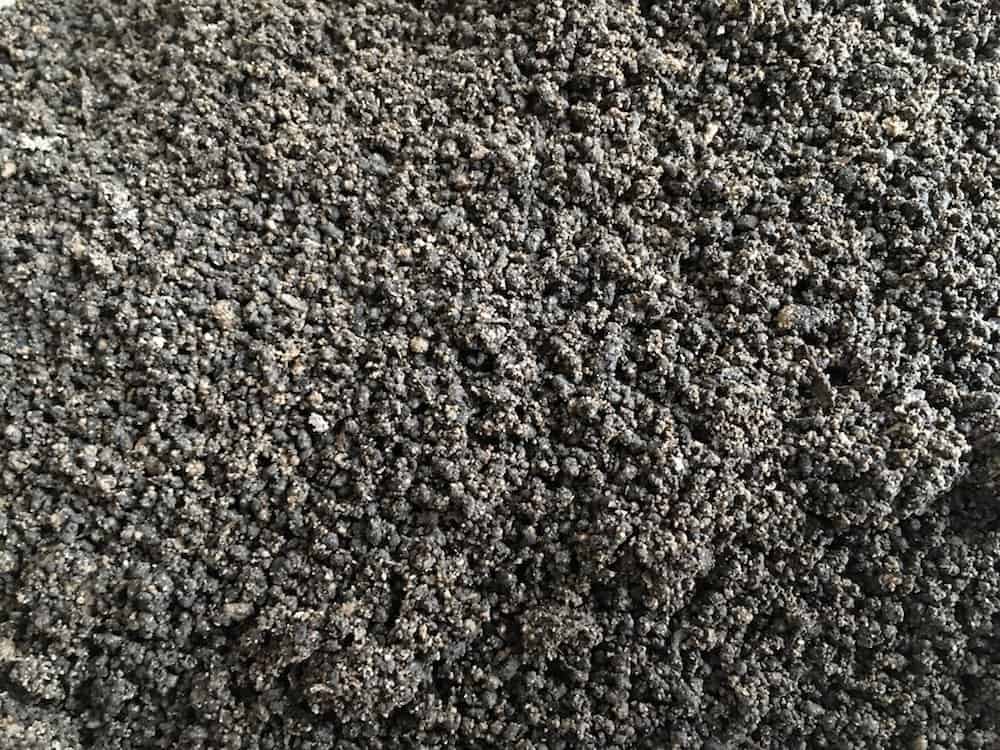
3. Animal manure (omnivore)
Animal manure from certain animals can be a good source of nitrogen for amending soil. Chicken manure is the most commonly used high-nitrogen livestock manure. Specialty animal poop like earthworm castings and bat guano is also quite common.
Composted poultry manure
Manure from poultry like chickens, ducks, and turkeys is high in nitrogen in comparison to other livestock manures. Poultry manure must be well composted before using it as a soil amendment. It is concentrated enough that it can easily “burn” plants if you’re not careful.
Poultry manure is available from poultry farmers or from friends with backyard chickens. Many garden centers stock composted poultry manure, and it is even sold in bags online. Be aware that d
Bat Guano (7-3-1)
Poop from bats and seabirds can also be used as a high-nitrogen fertilizer. Down to Earth All-Natural Fertilizers sells OMRI-certified 7-3-1 Bat Guano Nitrogen-Rich Fertilizer in a 2-lb box.
Worm castings (1-0-0)
Continuing on the poop theme, worm castings are a reliable nitrogen source for garden plants. Make your own in a vermicompost bin or buy pre-packaged worm castings to add to your garden soil.
4. Plant-based nitrogen fertilizer products
Leafy plants are high in nitrogen, and so are many fertilizer products made from them. Plant matter from some types of seaweed, corn, and fruit products is converted into plant-based fertilizer.
Seaweed fertilizer (1-0-2)
Fertilizer derived from seaweed is high in nitrogen. Kelp meal is a common form of seaweed fertilizer.
Alfalfa meal (2.5-0.5-2.5)
Alfalfa meal is a readily available nitrogen source that comes from plants. It’s also a rich source of trace elements and natural growth stimulants. Alfalfa meal is commonly used to fertilize flowering shrubs like roses.
Neem seed meal (6-1-2)
Neem seed meal is another plant-based source of nitrogen for the garden. This is a slow-release nitrogen fertilizer pressed from the seeds of the Neem Tree. Popular organic fertilizer brand Down to Earth offers Neem Seed Meal in a compostable 5-pound box.
Corn gluten meal (9-0-0)
Corn Gluten Meal is a nitrogen-rich soil amendment also known as “natural weed & feed”. In addition to providing nitrogen to the soil, it also helps prevent weeds from becoming established in the spring if applied before the weed seeds germinate.
Fruit vinegar
Diluted fruit vinegar like apple cider vinegar, can be an effective high-nitrogen soil amendment for acid-loving plants.
5. Fish & animal by-products
Fish & animal by-products are a common source of nitrogen in generic and name-brand fertilizers. Examples of materials used to add nitrogen to the soil are fish emulsion, feather meal, and blood meal.
Feather meal (12-0-0)
Feather meal is used as an organic fertilizer because it is rich in nitrogen, contains no phosphorus, and doesn’t have some of the odor problems of other animal by-products. Feather meal tests at a whopping 12% nitrogen! That’s a lot of nitrogen in comparison to most other fertilizers (even synthetics). It’s also a slow-release food that can provide steady amounts of nitrogen to your plants.
Feather meals can be used to add nitrogen to vegetable gardens, container gardens, trees, and shrubs.
Blood meal (12-0-0)
Fish emulsion (5-1-1)
Fish emulsion is an organic fertilizer concentrate made from fish by-products. While it’s stinky, it can be used on all types of lawn and garden plants (although I would keep it outdoors if possible!). Fish emulsion is a manufactured version of the traditional practice of burying fish in cultivated soil.
6. Homemade compost enriched with plant matter
The following materials from around the house can also be a good source of nitrogen for plants. I like to let them compost with my yard waste first for a buffering effect rather than adding them straight into my garden.
Here are some natural sources of nitrogen to add to your compost pile:
- Grass Clippings
- Yard Waste (especially green leaves and green material)
- Food Waste
- Coffee Grounds
- Seaweed
- Cornmeal
- Earthworm Castings (from a home worm farm)
- Fruit Vinegars (like apple cider vinegar)
- Manure from Herbivore Animals (rabbits, goats, et cetera)
Homemade compost can be spread as a 1″-thick top-dressing on the lawn to boost nitrogen. It can also be spread as a mulch over garden beds and landscaped areas to give an attractive finished look that’s also a nutrient boost.
Your mix of nitrogen-rich materials will depend a lot on your surroundings. You may be able to get lots of freely available seaweed but have no access to herbivore manure. Whatever you have available in your region, collect it sustainably. Improving your garden soil shouldn’t come at the expense of the surrounding environment.
6. Nitrogen-fixing green manure cover crop
Cover crops work as “green manure” to enrich the soil with plant matter rather than animal waste. Certain cover crops are known as “nitrogen-fixers”, and can pull nitrogen from the atmosphere down into the soil. Here are some common nitrogen-fixing cover crops you can plant and grow to add nitrogen to your soil without hauling in fertilizer or manure!
- Crimson Clover for early fall planting
- Iron Clay Pea for late spring planting
- Austrian Winter Pea for early fall planting
- Marvel Chickpea for spring or fall planting
- Fava Beans for spring or fall planting
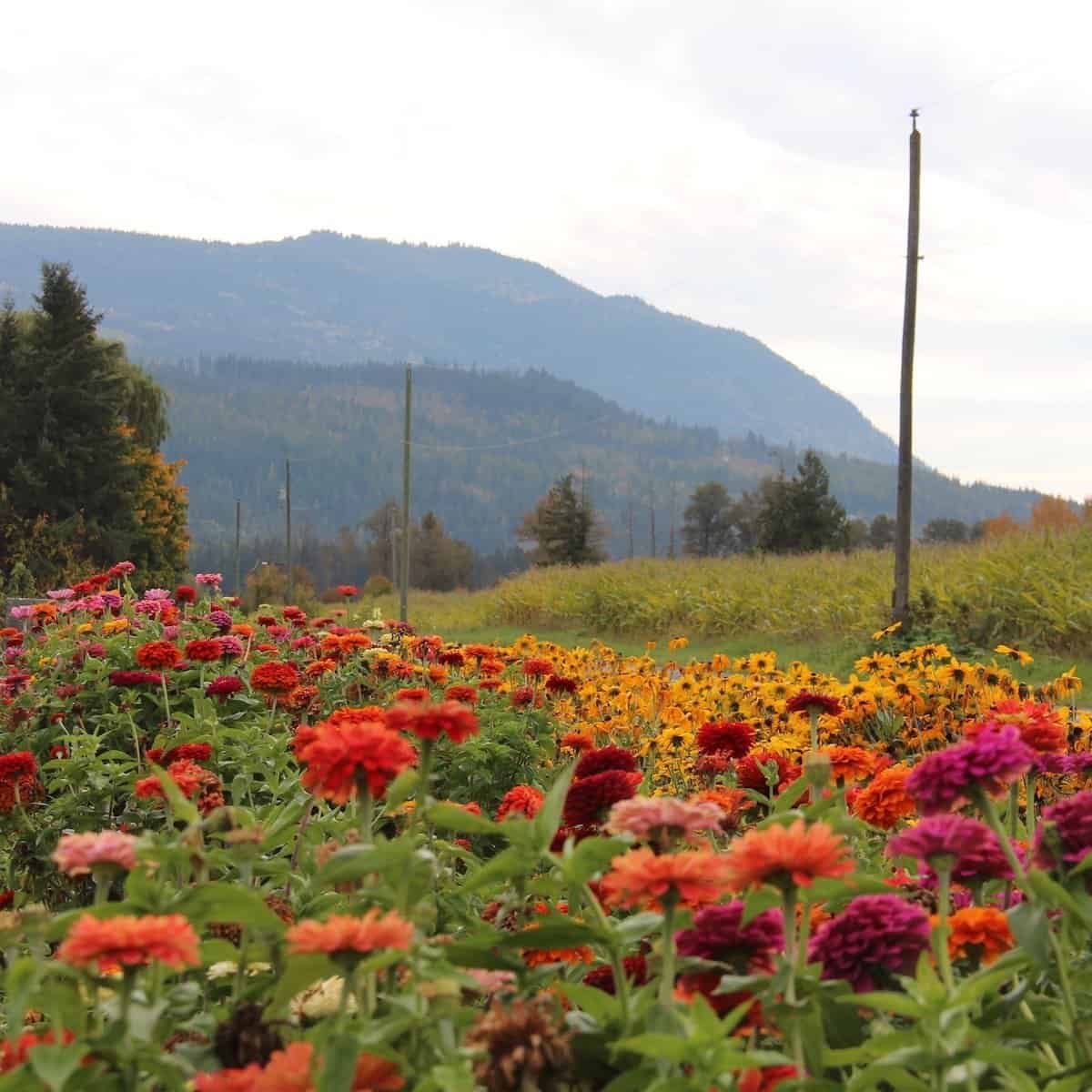
How nitrogen is added to soil?
Nitrogen is a common element in the Universe. It’s actually the most common element in the air that makes up Earth’s atmosphere. But unfortunately for our plants, it’s not super common in the Earth’s crust (AKA our garden soil).
Nitrogen particles move through our environment in a cyclical manner. It’s converted into different forms as it moves through different structures in ecosystems. Bacteria can help bring atmospheric nitrogen down into the soil (especially on legume plants like clover, peas, or alfalfa). Nitrogen particles in the soil can also be transported through the soil by groundwater.


